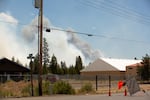Oregon Gov. Tina Kotek addressed a group of reporters Friday to detail the state’s response to a series of wildfires that have cropped up around the state this month.
“Our wildfire season is off to a very aggressive start,” Kotek said.
This year, the governor has already declared five emergency conflagrations in response to various fires, which allows the state to use its resources to protect life and property.

FILE: A helicopter battling the Darlene 3 fire flies overhead with a helibucket in tow in La Pine, Ore., on June 26, 2024.
Kathryn Styer Martínez / OPB
Oregon has been no stranger to increasingly numerous and destructive wildfires in recent years, which scientists say is a by-product of human-caused climate change.
This year, though, the fires are starting earlier than expected and spreading quickly, a worrying sign as the wildfire season nears its traditional peak in August.
What’s causing all of the fires?
Most of the major wildfires this season have been human-caused, according to Jessica Neujahr from the Oregon Department of Forestry. The most common cause is people burning debris around their home, which can lead to embers escaping and fires sparking in the surrounding area. Loose tow chains and gas-powered lawn mowers can also inadvertently spark a fire in dry grassy areas.
“We have been seeing a trend of a lot of human-caused fires, which is also why we’re really urging the public to participate in wildfire prevention and avoid putting fire hazards on the landscape,” Neujahr said.
Officials, though, are now concerned with a fire starter they can’t easily control — lightning. Kotek said lightning strikes have already caused more than 100 small fires earlier this week, mostly in central Oregon.
With more lightning expected to arrive this weekend in central and southern Oregon, fire experts are expecting that trend to continue.
Why is this year’s wildfire season so severe?
Oregon has seen record-breaking heat across much of the state this summer, especially in southern and eastern Oregon, which have seen temperatures at or above 110 degrees. At least 16 people have died from suspected heat-related causes.
The extreme heat has led to incredibly dry conditions that make it easy for wildfires to start and rapidly spread.
Oregon State Fire Marshal Mariana Ruiz-Temple said Oregon has already seen two “megafires” — any fire greater than 100,000 acres — with the Cow Valley Fire near Vale and the Falls Fire just north of Burns.

FILE: A forest fire burns just beyond road closures at Reed Road and Russell Road on the eastern edge of La Pine, Ore., on June 26, 2024.
Kathryn Styer Martínez / OPB
The Cow Valley Fire is Malheur County’s first conflagration in 29 years. Ruiz-Temple said that’s indicative of the incredibly dry conditions.
Oregon State associate professor E.J. Davis said the total number of acres burned this year — nearly 400,000 acres total — is already greater than all those burned during 2023.
What’s the outlook for the rest of the season?
Davis said, despite the early start, this year’s wildfire season should end at its traditional point around late September to early October. Until then, wildfire conditions will largely depend on the weather, especially future lightning and wind events.
In the meantime, residents in areas prone to wildfires are encouraged to prepare and listen for any evacuation orders.
Department of Emergency Management Director Erin McMahon said so far there have been 88 evacuation orders issued this year due to wildfires.
